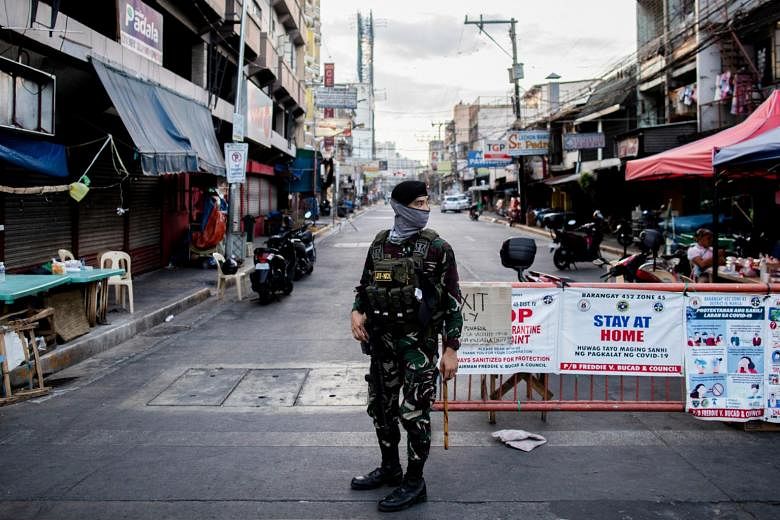MANILA - President Rodrigo Duterte has extended a sweeping lockdown in Metro Manila and two other urban centres till the end of May, even as restrictions that have so far led to massive job losses and a crippled economy are eased elsewhere.
"There will be areas that will remain on lockdown… We have to do this gradually, or risk falling down. We cannot afford a second or third wave… because we're not following rules," Mr Duterte said at a briefing aired on Tuesday (May 12).
"Covid-19 is very lethal," he stressed. "Don't gamble with your lives… It can go either way. You can go either to your funeral or you can just sleep at home.
"You don't have to die. Just follow the government's orders, and you will live," he said.
His spokesman Harry Roque told reporters later in the day that Metro Manila would remain on lockdown for 15 more days.
Metro Manila, the capital region, spans 16 cities and is home to more than 13 million people.
With the 15-day extension, it will now be on lockdown for as long as Wuhan in China where the virus was first detected.
Apart from Metro Manila, Cebu City, a key gateway in central Philippines, and Laguna province, south of Manila, would also still be on lockdown till at least the end of May.
These three areas account for close to 9,000 out of more than 11,000 cases of infections from Covid-19 recorded across the country.
At least 726 people have died so far, of which 526 are in Metro Manila.
Lockdown restrictions will be eased for the rest of the Philippines after May 15.
'MODIFIED' LOCKDOWN FOR METRO MANILA
Mr Roque said Metro Manila would be on "modified enhanced community quarantine".
That means some companies, factories and processing plants will be allowed to reopen, but with only half their usual number of employees, in line with social distancing guidelines, he explained.
Trains, buses, jeepneys, taxis, ride-sharing services and motorised rickshaws can again hit the road.
But they can take only passengers who are going on "essential runs", such as buying groceries and medicines, or heading to work for firms allowed to reopen.
Everyone else will still have to follow movement and shelter-at-home restrictions, and mayors can place districts in their cities still reeling from widespread viral transmission under "hard lockdown", which means no one gets in or out, and everyone must be inside their homes.
"We're doing this so we can gradually reopen the economy," said Mr Roque.
Metro Manila has been effectively shut off from the rest of the Philippines and the world since mid-March.
All domestic flights and sea travel, except for those transporting essential goods, have been suspended.
Companies have wound down and sent their workers home, except for those working in sectors such as food and medicine, utilities, banks, telcos and logistics firms.
Finance Secretary Carlos Dominguez on Tuesday said up to 1.5 million workers had lost their jobs.
Mr Carlito Galvez, head of the Covid-19 task force, said the lockdown in Metro Manila would have to be eased soon, reiterating concerns raised by many local officials and businessmen.
"Government cannot endure the (enhanced community quarantine) for an extended period of time, as its resources are very limited. It has to balance health and the economy," he said.
CURVE IS STILL NOT FLAT
A task force overseeing efforts to slow the spread of the virus earlier considered easing quarantine restrictions in cities in Metro Manila that were recording fewer cases.
But Mayor Edwin Olivarez, chair of the Metro Manila Council, said a city-by-city easing was not doable.
"It cannot be different per city," he said, noting that mass public transport cannot restart in one city, and not in another.
Trains, for instance, traverse across many cities in Metro Manila, he said.
"We still haven't flattened the curve… What we're really afraid of is a more severe second wave," he added.
On Saturday, a team of experts from the state-run University of the Philippines warned that easing the lockdown in Metro Manila too soon could lead to at least 1,700 deaths by mid-June and 24,000 new infections.
A leading health expert and technical adviser to the government earlier said the lockdown across much of the Philippines had succeeded in slowing the spread of the coronavirus, with recent numbers suggesting a "flattening of the curve".
Dr John Wong, an epidemiologist, said the data supported a gradual lifting of draconian quarantine measures.
The data showed that "the speed has slowed down considerably", he said.












